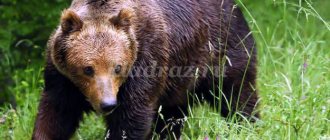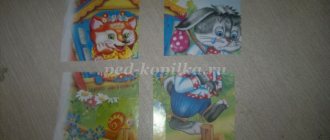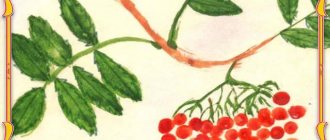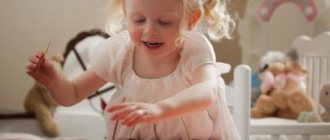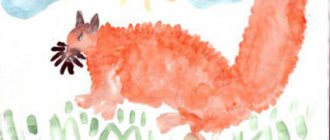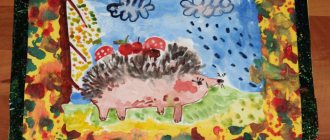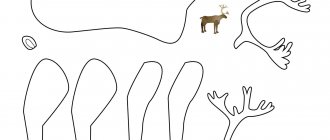Progress of the lesson:
Educator: Guys, today I suggest you go to a clearing where forest animals . Would you like to go with me?
Educator: Well then, grab your hands and follow me.
Educator: guys, look what this is? It looks like these are someone's tracks , but where are the forest animals ? Guys, maybe you know?
(children's opinions are listened to)
.
Educator: It’s possible that they got scared of us and ran away. Let's find them, and we'll look for them by tracks . First, you need to guess who has what marks ? (I help the children guess who has what marks ,
(we found a squirrel in a tree, a fox in a hole, a bunny behind a bush)
.
Educator: clever guys, we found forest dwellers , now let's invite them to visit us (sit down at the tables)
.
Educator: guys, since we invited a bunny, a squirrel and a fox to visit, let's please them and draw pictures for them. (children draw animal tracks with their fingers )
.
Educator: Well done guys, you tried very hard and the drawings turned out beautiful, I think the forest animals will no longer be afraid of us and will come to visit us more than once (children give their drawings)
.
Educator: Kropotova E. G.
Presentation of a group on non-traditional drawing techniques At the age of ten, at seven, and at five All children love to draw. And everyone will boldly draw everything that interests him. Everything is of interest: Distant.
The influence of non-traditional drawing methods on children's positive emotions. From work experience (abstracts) Theses of accumulation of experience in non-traditional drawing techniques for preschoolers of the teacher of MBDOU kindergarten No. 29 Lena Sagitovna Asfatullina.
Source
Summary of a drawing lesson in the second junior group “Wild animals. Hare in the snow"
Zhanara Disingazieva
Summary of a drawing lesson in the second junior group “Wild animals. Hare in the snow"
Topic of the lesson : “ Wild animals . Hare in the snow ."
Goal: to teach children to poke with a hard, semi-dry brush. Develop the ability to listen to a nursery rhyme and imitate the movements of a hare along the text. Give an idea of the life of a hare in the forest in winter.
Objectives: teach children to poke with a hard semi-dry brush inside the contour; convey in the drawing the features of the appearance of the hare. Strengthen technical drawing (hold the brush correctly)
.
Intensify the use of speech words denoting the characteristics of a rabbit’s fur (fluffy, soft, white, etc.)
. Improve dialogic speech. To develop children's aesthetic perception of winter nature. Promote the development of curiosity.
snowfall while walking ; looking at illustrations of bunnies; reading fairy tales.
Demonstration material: bi-ba-bo fox doll.
Handout: album sheet with an outline image of a hare on a blue background; white gouache; hard brush;
Abstract of GCD in junior group 1: Wild animals in winter
Lesson on a winter theme in the 1st junior group.
Abstract Author: Bykova Natalya Ivanovna, teacher. Place of work: MDOU “Child Development Center - kindergarten No. 110 “Little Red Riding Hood”, Petrozavodsk, Republic of Karelia.
Direct educational activities in the 1st junior group.
Topic: “Wild animals in winter.” Educational areas: “Social and communicative development”, “Cognitive development”, “Speech development”, “Physical development”. Goal: To give children an idea of wild animals, their characteristics, habits, and nutrition. Objectives: 1. “Cognitive development”: To form in children ideas about animals - inhabitants of the forest (hare, squirrel, fox, wolf, bear), their appearance, nutrition, and lifestyle features. Talk about how a bear prepares for winter. 2. “Speech development”: Develop children’s speech, the ability to listen to the teacher, answer questions, repeat after the teacher. Develop the ability to solve riddles. Enrich children's vocabulary. Vocabulary work: winter, forest, fox, bear, hare, wolf. 3. “Social-communicative”: Contribute to the creation of a favorable psychological atmosphere in the classroom. Arouse interest in playing together with an adult. Develop the ability to build dialogue with adults and peers. Cultivate interest and love for animals, a desire to care for them. 4. “Physical development”: Learn to move, imitating movements characteristic of a fox, wolf, hare. Develop coordination of movements. Methodological techniques: visual, verbal, game, guessing riddles, artistic expression, questions, surprise moments, musical (“lullaby”). Preliminary work: Learning songs and poems on the theme of wild animals. Situational conversations on this topic. Looking at illustrations of “wild animals”. Russian folk game “Fox and Hares”, “The gray bunny is sitting”, “The bunny is jumping, jumping”. Equipment and material: Composition “Winter Forest”;
wild animal toys: hare, fox, wolf, bear, squirrel; basket; treat for animals: a barrel of honey, raspberries, a toy fish, mushrooms, nuts, meat (a replica from the game “shop”). Progress:
The teacher invites the children to go into the forest.
Educator: Guys, do you want to go into the forest with me? Wild animals live in the forest. Let's get them a treat. On the table are dummies for playing shop: raspberries, a barrel of honey, a toy fish, carrots, mushrooms, nuts, meat. The teacher offers to put all the products in a basket. Children name each item and put it in a basket. Educator : It’s winter now, there’s a lot of snow in the forest. And it’s hard for us to walk in the snow! Let's sit down quietly and I'll tell you a poem about a bear. You can’t find a bear’s trail in winter, Zimushka sent Mishenka to bed. In the den he sucks a sweet paw, And he dreams that he eats honey. Mishka purrs contentedly with joy. Hey, animals, be quiet... Let Misha sleep. (Gusarova T.) The teacher draws the children’s attention to a bear cub lying under a tree. Educator: Hush, children, the bear is sleeping! You won’t see him in the forest in winter, because the bear sleeps in a den for the winter. To make the bear sleep better, let's sing him a lullaby. Children with a teacher sing “Lullaby”, music. E. Tilicheeva, lyrics. N. Naydenova. 1. Bye-bye, bye-bye! Sleep, my teddy bear, go to sleep. 2. Hurry up and close your eye. Get some sleep, get some sleep for an hour. 3. Bye-bye, bye-bye! Sleep, my teddy bear, sleep! The children sing along and lull the bear to sleep. Educator: Guys, what will we give the bear as a gift, what kind of treat? Children choose raspberries and honey, take them out and leave them next to the teddy bear. Educator: The bear will wake up, see raspberries and honey and be happy. Let the little one sleep, and you and I will take a walk through the winter forest. We will walk quietly so as not to wake the bear. The teacher shows a toy hare. Educator: Oh, look, children, who we met in the forest! Who is this? (bunny) What kind of bunny? (white, soft, fluffy). In winter, the bunny's fur is white as snow, so that the wolf and the fox would not notice him in the snow and would not catch him. What kind of ears does the hare have? (long, sensitive - hear well). The bunny wants to play with you. Game with the Hare. There is a snowball on the ground (they run on their toes in a circle) The bunny runs through the snow. Jump - hop, jump - hop (they jump like bunnies) The bunny runs through the snow. Ears are freezing (stroke ears), Paws are freezing (stroke hands). Without boots and without a hat. (show) Jump - hop, hop - hop, (jump like bunnies) The bunny hid in a snowdrift. (squat down). Educator: The bunnies jumped merrily. What will we give the bunny, what does he like to eat? Children choose a carrot and give it to the hare. Educator: Let's say to the bunny: “Eat, bunny, a carrot!” Educator: The hare was delighted with the gift and galloped further into the forest. The bunny runs fast and fast. Educator: Here is a little fox running - her red sister. The teacher shows the children a toy fox. Educator: The fox also doesn’t want to wake up the little one. She walks quietly, on her toes. Can you walk like that? Show it to the fox. Children do an exercise, imitate a fox. Educator: Guys, what kind of fur coat does the fox have? (red, fluffy) What kind of tail does the fox have? (long, fluffy, big). The fox really enjoyed playing with the guys. Shall we treat the fox? What will we choose for the fox? Children choose a fish and treat the fox. Educator: Let's say to the fox: “Eat, little fox, fish!” Educator: The little fox played and ran into the forest to eat fish. Educator: Listen, what forest animal is the riddle about: On a cold, gloomy winter day, a hungry beast walks and wanders. He prowls through forests and fields, And he looks for food for himself. Who is this? (wolf). The teacher shows a toy wolf. Educator: A wolf is hunting in the forest. He walks carefully so as not to frighten other animals. Show how a wolf makes its way through the forest. Children imitate the movements of a wolf. Educator: The wolf is a strong beast. What kind of fur does he have? (thick, gray). What kind of teeth does a wolf have? (spicy). What will we treat the wolf to, what will he like most? (we'll treat you to meat). Educator: Let's say: “Help yourself, little top, gray barrel!” Educator: The gray wolf ran further into the forest to hunt. Educator: It seems like some animal is sitting on a tree. Who is this? The teacher shows a toy squirrel. Educator: Who is this? (squirrel). What squirrel? (fluffy, small). What kind of tail does a squirrel have? (big, fluffy-fluffy). A squirrel lives in a hollow in a tree. She jumps from one tree to another. What does the squirrel like, what can we treat it to? (mushrooms, nuts) Children treat the squirrel. Educator: Let's say: “Help yourself, squirrel! Eat mushrooms and nuts!” Educator: The squirrel climbed onto the highest tree. The wolf won't get her, the fox won't get her. What a clever squirrel. Educator: Children, do you think we didn’t wake up the bear? Let's hear if the bear is growling? Children listen. Educator: You played so quietly that the little one didn’t even wake up. Did you enjoy a walk in the winter forest? Let's remember who lives in the forest? The teacher quietly puts a bag of carrots in the basket. Educator: Now it’s time for us to return to the group. Oh, look, guys, there’s something in our basket. What is this? (carrot). Who do you think put this on us? (bunny). The bunny also wants to treat you. Help yourself to some carrots! Let's say "thank you" to the bunny! It's time for us to return to the group.
We recommend watching:
OD summary on sensory development in the junior group on the topic: Winter Summary of a lesson in the 2nd junior group on the topic: Winter Summary of a lesson on cognitive development in the 2nd junior group on the topic: Winter Summary of a lesson on speech development on the topic: Winter in the 2nd junior group
Similar articles:
Summary of a game lesson for young children on the topic: Winter
Progress of the lesson.
Educator: Guys, listen to the nursery rhyme and you will find out who came to visit us.
Educator: That's right, bunny!
There is a knock on the door.
Educator: I wonder who else came to us?
He brings in the fox: the teacher puts a bi-ba-bo doll on his hand and says on her behalf: “Hello! Whoa, who do I see (a hare, I want to play hide and seek with you. I will turn my back, and you hide."
Educator: Guys, let's help the bunny, otherwise the fox will catch him and eat him! Shall we help the bunny?
Educator: What can we do to save the bunny?
Children's answers. The teacher praises and selects the most successful and inventive answers.
Educator: It’s winter outside, everything is covered with white snow . And the little hares in their gray fur coat stand out against the white snow .
Educator: What color is the fur of bunnies in winter?
Educator: Correct. A white fur coat is needed so that the hare is not visible in the snow . What other kind of fur do rabbits have?
Children: She is fluffy and soft.
Educator: Well done! In order for our bunnies to have the same fur, you need to pick up a little white gouache with a dry, hard brush, and, holding the brush vertically, make pokes on top inside the outline.
drawing methods .
Independent activity of children.
At the end of the lesson, the results are summed up .
Educator: Well done! Look what beautiful white and fluffy bunnies you have made! Well, little fox, you can look for bunnies!
Fox (addressing the children)
: “Now I’ll quickly find the hares.
(Looks at the children's work)
. Where are they? Well, again I couldn’t catch the rabbits. "
Educator: “Well done, guys! They helped the bunnies well.”
Photo report on a drawing lesson with children aged 5–6 years on the topic “Hare in the Snow” Our bunnies are fashionistas, They have changed their frock coats: Nowadays the hares are white, Even though they were grey. In autumn it is easier for gray people to live among gray nature, and in winter it is calmer.
Abstract of an integrated GCD on the topic “Wild animals. Hare" (early age) Purpose: Introducing children to wild animals. Objectives: To introduce children to wild animals; Teach children to understand the question and answer it;
Summary of educational activities for children of the second junior group “Let's help the squirrel. Wild animals" Problems. To consolidate children’s ideas about autumn, its characteristic features, and autumn natural phenomena. Reinforce the concept of “wild animals”.
Abstract of the GCD in the second junior group “Wild animals and their young” Purpose: to summarize children’s ideas about wild animals and their young. Objectives: Educational: Consolidating ideas about features.
Source
Notes on drawing in the first junior group “Wild Animals. Hedgehog"
Inna Rybkina
Notes on drawing in the first junior group “Wild Animals. Hedgehog"
Summary of GCD for drawing in the first junior group
Goal: Creating the image of a hedgehog in collaboration with the teacher: completing the “needles”
- from short straight lines.
Learn to use a pencil (wax crayon, draw straight lines from top to bottom.
Develop fine motor skills of the hands, develop aesthetic perception. Develop a sense of rhythm and color.
Foster independence in work and a desire to help.
Equipment: Hedgehog toy, sheets of paper depicting a hedgehog without needles, black pencils.
— "Communication"
Activate the words “needles and thorns” in children’s speech. Answer the teacher's questions.
— "Cognition"
Introduce children to
the animal hedgehog (what it is, where it lives)
.
Notes on drawing in the first junior group Topic: “Who lives in the forest?”
Notes on drawing in the first junior group
Topic: “Who lives in the forest?”
Tasks:
Educational:
to develop children’s ability to convey animal tracks with brush strokes. Continue to introduce wild animals and the habits of wild animals.
Educational:
develop the ability to work with a brush, pick up the required amount of paint. Apply short and wide strokes.
Educational:
cultivate independence and accuracy. Develop the ability to listen carefully to the teacher.
Methods and techniques:
game (surprise) moment, visual, artistic expression, verbal (story, explanation, conversation, questions), practical part, encouragement, individual work, outcome behavior.
Equipment:
sample drawing (image of a winter forest), paint (brown or black), brushes, napkins, glasses of water, easel, sheets of paper with applique Christmas trees.
Progress of educational activities:
Teacher (shows the children an image of the forest and the animals living in it): - Guys, look in the forest there are many different wild animals. What wild animals do you know (children's answers). Why are they called wild? (because they live in the forest and not near humans).
- Right. In the forest we can meet a hare, a squirrel, a wolf, a fox, and a bear. They all live independently and do not require human care.
- Let us turn into wild animals.
On a hot day, the animals walked along a forest path to a watering hole.
(Children walk in a circle, one after another) A calf stomped behind the mother elk,
(They walk, stomping loudly) A little fox sneaked behind the mother fox,
(They go stealthily) A hedgehog rolled after the mother hedgehog,
(They move in a deep squat) A bear cub followed the mother bear,
(They move in a deep squat) The baby squirrels jumped after the mother squirrel,
(They jump on their toes, bending their arms in front of their chests) Behind the mother hare are slanting hares,
(They jump, making “ears” from their palms) The she-wolf led the wolf cubs behind her.
(Walk on all fours) All mothers and children want to get drunk.
(Walk on all fours)
Educator: - Many animals live in the forest! And each of them leaves their footprints in the snow. (The teacher draws attention to the picture of the forest.)
Here's a little bunny galloping along.
(Draws footprints on the easel with small strokes.)
And here a bear was stomping.
(Draws large strokes.)
These are the animals that walked through my forest. What animals do you think will run by?
Children draw large and small footprints on sheets of paper with a Christmas tree appliqué.
When all the drawings are ready, the teacher asks each child whose footprints he depicted.
– What animals live in the forest?
– How do they walk through the forest (sneak, jump, clumsy)?
– What are the tracks of a hare (bear)?
“Now it’s time to go back to kindergarten.” One, two, three, we are not animals - we are children.
— Did you like playing wild animals? What did you like most? What do you remember? What new did you learn? What have you learned?
The teacher organizes an exhibition of children's works. Together with the children, he examines the work and guesses the traces of which animals the children depicted.
